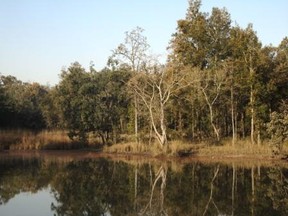 The charismatic deer once survived in large numbers as far as Upper Sind now its range is critically restricted due to the decimation of most of its grassland habitats.
The charismatic deer once survived in large numbers as far as Upper Sind now its range is critically restricted due to the decimation of most of its grassland habitats.
Swamp deer are found in Lakhimpur Kheri Tiger Reserve and Jhilmil Jheel Conservation reserve in the North, at Kaziranga and Manas in Assam State, and in Central India at Kanha National Park. The scientific classification stands as Recervus duavcelli in North India and Nepal. It is Recervus duavcelli ranjitsinghji in Assam and Recervus duavcelli branderi in Kanha in Central India.
The animal in the picture here is the Brander Barasingha at Kanha Tiger Reserve. Barasingha is a Hindi name that means twelve tines hence deer with twelve tines or branches of antlers. In English, it is called swamp deer or hard-ground swamp deer in this case.
The difference in the case of this animal from its cousins is that it has evolved to survive on the hard ground through thousands of years of evolution. The difference has arisen in the hoof which is less splayed whence compared to other swamp deer in India. This constriction in the hooves enables the animal to trudge on hard ground with ease.
Since the marshy grasslands are no more present, evolution was necessary in order to survive. Being a shy animal, it does not venture out of the core zone or critical tiger habitat. Hence its survival is totally dependent upon inviolate protected areas in India and Nepal.
The animal is one of the most charismatic in the whole of Kanha with majestic multi-tined antlers a graceful body and enigmatic continence. The male weighs around one hundred eighty kilograms and stands at four feet while the female is smaller with no antlers it is equally lithe and graceful.
The robust Rufus fur changes as per the season the winter coat being the most attractive to look at and photograph. The underbelly and inside of the legs are white in stark contrast to the upper body.


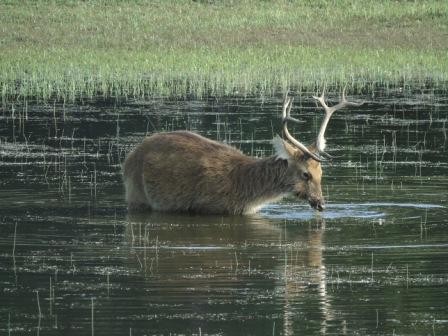
 The charismatic deer once survived in large numbers as far as Upper Sind now its range is critically restricted due to the decimation of most of its grassland habitats.
The charismatic deer once survived in large numbers as far as Upper Sind now its range is critically restricted due to the decimation of most of its grassland habitats.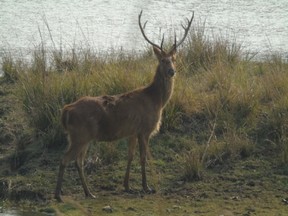 This is the timidest animal I have seen in the grasslands. Yes, it is a graminivore and survives on grass and aquatic vegetation. Various species of grass found in Kanha constitute its diet which is also supplemented by seasonal aquatic vegetation found in numerous medium-sized water bodies in the reserve.
This is the timidest animal I have seen in the grasslands. Yes, it is a graminivore and survives on grass and aquatic vegetation. Various species of grass found in Kanha constitute its diet which is also supplemented by seasonal aquatic vegetation found in numerous medium-sized water bodies in the reserve.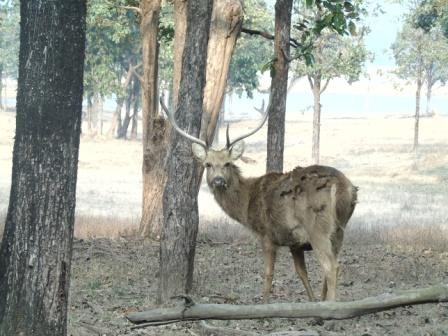
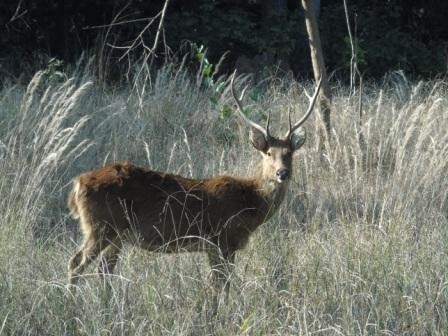
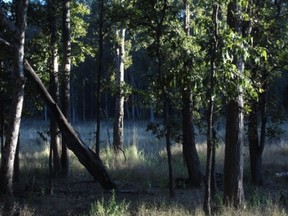 The flourishing population of hard-ground barasingha is breeding well and their numbers are constantly rising. They are found in extensive grassland habitats and near water bodies of core in the tiger reserve. Since robust grasslands do not exist in the buffer or outer area of the park and are extremely shy, they limit themselves to the core or the critical tiger habitat.
The flourishing population of hard-ground barasingha is breeding well and their numbers are constantly rising. They are found in extensive grassland habitats and near water bodies of core in the tiger reserve. Since robust grasslands do not exist in the buffer or outer area of the park and are extremely shy, they limit themselves to the core or the critical tiger habitat.





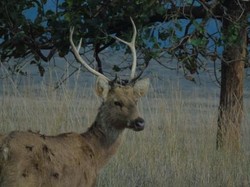

 Full Day Safari in Bandhavgarhon 08/29/2023
Full Day Safari in Bandhavgarhon 08/29/2023
 SEO Campaign: Website Overhaulon 02/13/2023
SEO Campaign: Website Overhaulon 02/13/2023
 Indian Food It Is Not All Curryon 02/08/2023
Indian Food It Is Not All Curryon 02/08/2023
 How Tiger Tourism is Organized in India?on 02/07/2023
How Tiger Tourism is Organized in India?on 02/07/2023

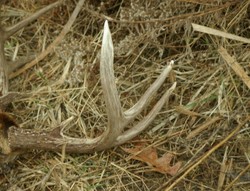
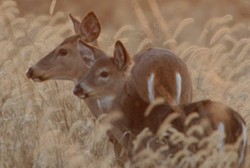
Comments
The tribal and other local people are conversant in Hindi and few of them now know useful English. I will have to find out when the Arc at Kanha was built!
Thank you!
The search term Kanha National Park swamp deer antler ark brought up the YouTube Majestic Arc Gate Made by Deer Antlers in Kanha National Park, with WalkThroughIndia Traveller April 17, 2021.
The sound does not come clearly through the computer that I'm using so I don't know the language that is being spoken. Beneath the ark so impressive in condition and shape is a beautiful, clean plaque with an extensive write-up.
When was the ark built?
What would be the language of the people who live in the Maikal range of Satpuras that the Kanha National Park site identifies as where it nestles into Madhya Pradesh? Which languages -- Hindi? English? -- would park personnel be expected to know in interacting with guests?
They are left to decompose naturally. However, with proper permissions and objectives, park personnel can collect a few of them. Under any circumstances, the discarded antlers cannot be used commercially or as a collector's item, this applies to all park personnel.
At Kanha National Park there is an ark made of swamp deer antlers collected from the park.
Your third subheading, Swamp Deer Habit & Social Behaviour, describes male swamp deer as shedding "their antlers once a year after breeding is over. The new antlers grow after this covered in pink velvet and grow full length by the time of mating."
Do park personnel collect the shed antlers or leave them to decompose naturally where they fall?
That is fur loosening post winters. Thanks!
pateluday, Thank you for the pictures and the practicalities.
What are the marks that cluster toward the rump on the deer images below the headings red deer in grass and stag swamp deer?